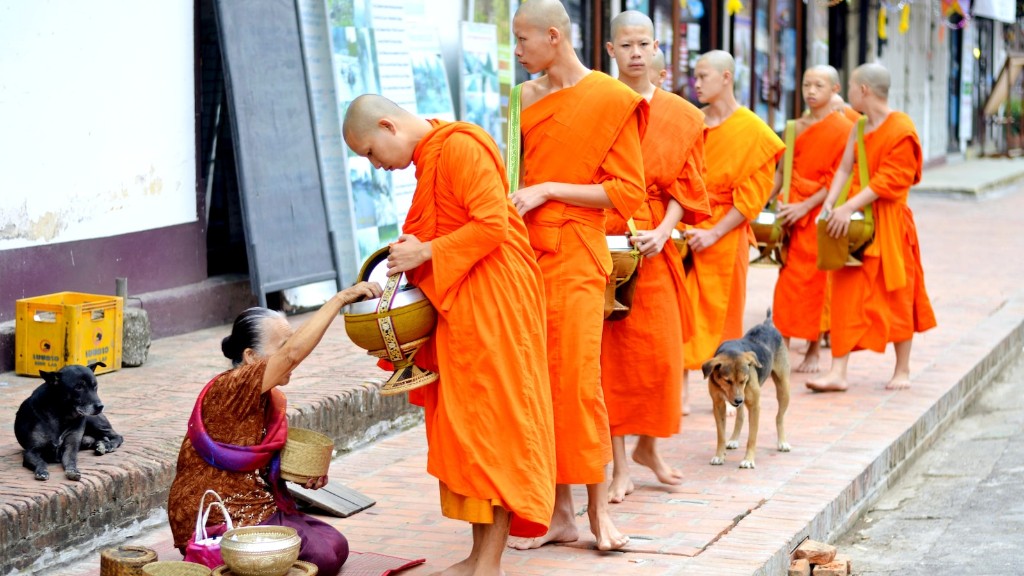Symbols of Hinduism: Overview
Hinduism is an ancient religion originating in India with a rich history of traditions and beliefs. Symbols of Hinduism help to define the faith and to connect on a spiritual level with the deities of the Hindu pantheon. These symbols are also commonly used in temples, homes, and other sacred spaces throughout India. This symbol-based faith has been practiced for centuries, and the symbols of Hinduism have been deeply woven into the fabric of Hindu culture.
The symbols of Hinduism typically include the three main gods – Brahma, Vishnu, and Shiva, or their associated symbols. Other symbols of Hinduism include lotus and conch shells, the swastica, the sun and moon, the trident, and the Om sign. Various symbols have both ritual and spiritual significance to Hindus.
Symbols of the Trimurti
The Trimurti, sometimes known as the Hindu trinity, is a belief system of three gods – Brahma (the creator), Vishnu (the preserver), and Shiva (the transformer) – personifying all facets of reality. Brahma is often referred to as ‘the creator of the universe’ and his four heads represent the four Vedas, the ancient scriptures of the faith. He is often depicted with four hands and rides on a great goose. Vishnu is sometimes called ‘the preserver of the universe’ and is associated with protection, healing, and preservation. He is often depicted as having four arms and riding on a giant eagle. Shiva is sometimes referred to as ‘the destroyer of the universe’ and is associated with transformation and regeneration. He is commonly depicted with four hands, carrying a trident, a drum, and holding a snake.
Other Common Symbols
The lotus is associated with beauty, spiritual purity, fertility, and prosperity. It is sometimes seen floating on the water or growing atop a majestic mountain. The conch shell, sometimes known as Shankha, represents the sound of the divine and is associated with the concept of immortality and eternity. The Swastika, sometimes known as sauvastika, is an ancient symbol depicting the sun and is associated with auspiciousness and good luck.
The sun and moon represent the cycle of life, death, and rebirth. The trident, commonly associated with Shiva, represents the triple aspects of life – physical, mental, and spiritual. The Om sign is associated with the ultimate unity of creation and the union of all souls.
Symbolic Significance
Symbols of Hinduism help to define the religion and to express its ancient beliefs. They are powerful symbols that help to deepen one’s understanding of the faith. Hindus believe that the symbols of Hinduism represent a connection to the gods and goddesses of the Hindu pantheon, and that they serve to open one’s heart and soul to the divine.
The symbols of Hinduism are also used as physical markers of the faith in temples and other sacred spaces. They are an important part of Hindu culture, and they often feature prominently in artwork, jewelry, and other decorative items.
Spiritual Significance
Symbols of Hinduism represent the different gods and goddesses of the Hindu pantheon, and they also represent the cycles of life, death, and rebirth that make up the Hindu religion.
The symbols of Hinduism can also be used as mantras or symbols to meditate upon. Hindus believe that meditating on these symbols can bring about inner peace and balance, as well as lead to a deeper understanding and connection with the divine.
Symbolic Rituals
Symbols of Hinduism are often used in religious rituals to invoke deities or to bring about healing and transformation. For example, Hindus often use sacred incense and mantras during puja (the rituals of devotion) to connect with the divine. These symbols can also be used to mark the start of ceremonies, festivals, and other occasions.
Role in Everyday Life
Symbols of Hinduism are often visible in everyday life in India. Many Hindu families have symbols of the faith prominently displayed in their homes, such as images of Ganesh, the god of knowledge and wisdom. These symbols can be seen around temples and other sacred spaces, while they are also commonly featured in Hindu artwork and jewelry.
Symbols of Hinduism are a powerful way to connect with the faith, and many Hindus believe that these symbols can bring about positive change and spiritual growth. They are often used as tools of insight and reflection, and as reminders of the power of the gods and goddesses of Hinduism.
Symbols of Dharma
Dharma is the unifying law of the Universe. It is the moral and ethical code of Hinduism. Symbols of Dharma are often used to remind Hindus of their spiritual obligations. These symbols often include Ganesh, the god of knowledge and wisdom, as well as symbols of the four Vedas. Dharma is often depicted as an elephant, and it is also commonly associated with the sacred lotus.
Symbols of Yoga
Yoga is a spiritual and physical practice that is an integral part of Hinduism. Symbols of yoga often paint a picture of inner peace and balance. These symbols usually include the Om sign and the trident, which are often used to remind practitioners of their connection to the divine.
The lotus is also a popular symbol of yoga, as it is often used to depict the spiritual awakening that yoga can bring about. Other symbols of yoga include the four directional winds, which are associated with detachment, and the yoni, which is seen as a symbol of feminine power.
The Role of Mantras
Mantras are sacred utterances that are used in Hinduism to invoke divine help or to bring about positive change. Symbols of mantras are often seen in Hindu rituals and can also be used as a tool of meditation. Symbols of mantras often include the Om sign and the swastika.
Mantras are often associated with spiritual healing, and they are also commonly used to attract wealth, bring about new beginnings, and find inner balance. They are often seen as sacred tools of spiritual awakening and enlightenment.
